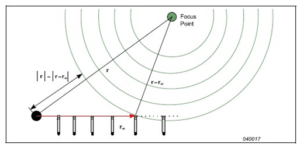Near field acoustic beamforming with improved source localization provides superior voice quality in teleconferencing and other applications. It supports planar, cylindrical, and spherical microphone array orientations. The maximum number of microphones that can be processed by the acoustic beamforming algorithm for real-time applications is limited by the capabilities of the processor.
VOCAL’s acoustic beamforming software package includes algorithms to determine the source location and dynamically steer and focus a beam at the source. Our near field acoustic beamforming software is optimized for leading DSPs and conventional processors from TI, ADI, ARM, Intel and other vendors. Contact us to discuss your beamforming application requirements.
Near Field Acoustic Beamforming
In the near field acoustic beamformer, an acoustic source signal of frequency, ƒ, is considered in the near-field when d < 2cl2 ⁄ λ, where l is the total size of the microphone array, d is the distance of the signal from the center of the microphone array and c is the velocity of sound. In the near field, the acoustic wavefronts appear spherical in nature. When the distance is large enough (d > critical distance) relative to the size of the array, the acoustic wavefronts in the far field appears planar.
With knowledge of the source location in 3-D space, the near field beamformer can provide a focused beam at the source location. The time delays are computed such that the signals at the microphones of the array are time aligned assuming a spherical wave radiated from the focus point [1]. After time delays are determined using the correct field assumption for optimal results, time delay and sum beamforming is then performed to generate the focused beam.
The focusing time delays are given by:
More Information
References
[1] J.J. Christensen and J. Hald, Beamforming, Bruel and Kjaer Technical Review,No. 1, 2004.
